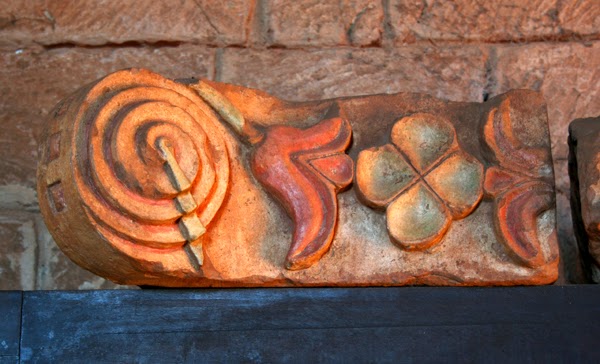 |
| Decoration with ochre, sienna and umber |
The
part of rural Paraguay that I briefly saw lies between the Paraguay and Paraná rivers,
where the landscape comprises gently undulating hills, with only a couple of places where I could recall distinctive geographical features. The
highest point is Cerro Peró, at an altitude of 842 metres,
but I only passed this place on the overnight coach to Ciudad del Este, which served as a base to visit the Iguassu Falls and the Jesuit Missions.
 |
| The Trinidad Mission in Paraguay |
Living in England, a small country, you don't feel that you are in the middle of nowhere, when visiting an ancient monument, with Hadrian's Wall being an exception but, at the Trinidad mission, I asked myself - how was this done?
The practicalities of arriving in Encarnación, or thereabouts, along the River Paraná, and then chopping through the vegetation, settling in this place, excavating a quarry and then moving all of the inorganic building materials - including lime and sand - to build this incredible place, are very daunting. Although a young girl did her very best to explain the history to my companions, there was nothing for me to read in English.
 |
| The museum at Trinidad Mission |
Looking closely at the various fine architectural details that can still be seen in situ, and in the small museum spaces too, I was amazed by the vivid colours that were preserved
Natural pigments such as ochre, sienna and umber, and others too, glowed brightly in the light that entered the room and, with the whole interior of the church decorated in an extravagant Baroque style, this must have been such a colourful place.
There was a small display that provided some information about the history of the mission but, again, not in English.
In the absence of natural rock exposures, a large expanse of stone masonry provides a wonderful opportunity to have a good look at the properties of the stone which, in this instance, is a medium grained, well cemented red sandstone.
 |
| Guaraní architectural sculpture |
In itself, the stone isn't that remarkable but the stone carvings, produced by the Guaraní, are quite astonishing, especially since they had no experience of building in stone before the Jesuits arrived.
There are numerous fine details to be seen but the pulpit, which is still in excellent condition, is considered to be one of the
finest examples of Guaraní art to be seen anywhere in South America.
The Jesuits founded socially motivated and self-sufficient
townships, not only imparting their religion but also establishing rules of
public order, education and society. The young, evangelical priests organized
the Guaraní into collectives and taught them new practical skills - the furniture and musical instruments were of such good quality that
they could be sold in Europe.
 |
| A frieze sculpture depicting angels with musical instruments |
Along with the nearby Jesús de Tavarangue Mission, Trinidad is
a World Heritage Site.
A total of 30 missions grew and prospered for 180 years and, at their height,
they accommodated 140,000 Guaranís. It is one of the most astonishing
experiments in colonization that the world has seen.
 |
|
The ruins of the Jesús de Tavarangue Mission |
As a geologist, I particularly liked the way in which the remains of some of the outbuildings have been conserved. With the overlying weathering details long since stripped away, a few courses of stone have just been left to decay naturally.
 |
| Conservation in Paraguay |